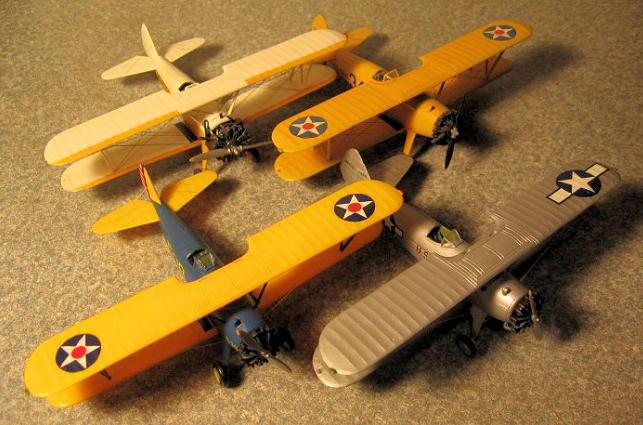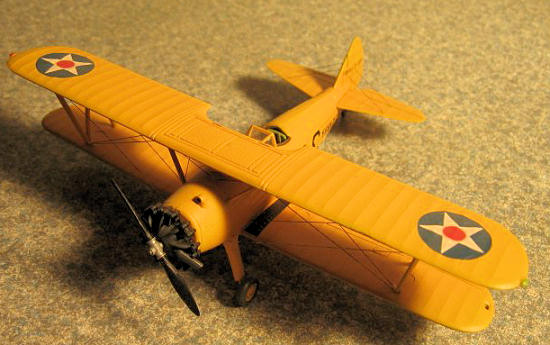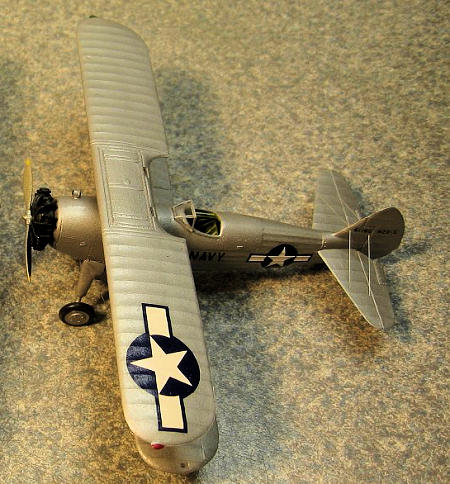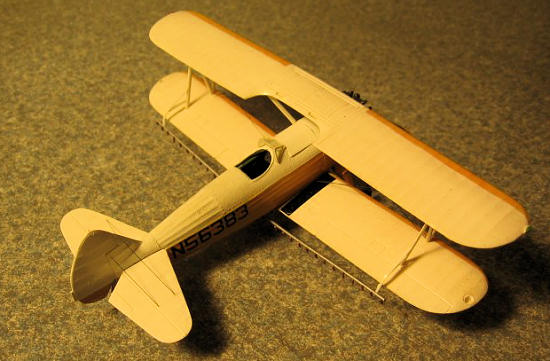
Revell 1/72 Stearman 'Kaydet'
| KIT #: | H-649 |
| PRICE: | $1.00 or less when new (1965). Can generally be found. |
| DECALS: | Normally one option |
| REVIEWER: | Brian Baker |
| NOTES: | Old kit with infinite possibilities for experienced modelers. |

| HISTORY |
The
Stearman 75, as it was known at the factory, became one of the major primary
trainers for the United States Army and Navy before the outbreak of World War
II, and production continued until late in the war when the training programs
were cut back. The Army and Navy
used a method by which trainee pilots began in either Stearman or Fairchild
primary trainers at military fields, , or sometimes light civilian aircraft,
such as Piper Cubs, Aeronca trainers, Taylorcrafts, or Luscombes operated by
civilian contract schools. This was called the Civilian Pilot Training Program,
and thousands of pilots were trained at these schools.
 Once
through the initial training period, pilots were trained by military
instructors, and a washout rate of 40 percent was considered normal, with
washouts becoming navigators, bombardiers, or other types of aircrew.
Student pilots learned basic flying skills, along with navigation and
acrobatics (now known as aerobatics).
Those trainees that mastered the primary trainers graduated to basic
training, where they did formation flying and navigation, using primarily the
Vultee BT-13. Students that
survived this course moved on the advanced training, where they invariably flew
the North American AT-6 or SNJ, and learned tactics, gunnery, instrument flying,
and other skills required for combat.
Fighter pilots moved directly into obsolete fighter types, while
multi-engine candidates went on to the Cessna AT-17, Curtiss AT-9, or Beechcraft
AT-11 before going on to operational bomber or transport types. Since there were
no two seat fighter trainers, the AT-6 and SNJ had to prepare the pilots so they
could fly fighters with only a cockpit checkout and “Take her up, and don’t
forget to lower the gear!”
Once
through the initial training period, pilots were trained by military
instructors, and a washout rate of 40 percent was considered normal, with
washouts becoming navigators, bombardiers, or other types of aircrew.
Student pilots learned basic flying skills, along with navigation and
acrobatics (now known as aerobatics).
Those trainees that mastered the primary trainers graduated to basic
training, where they did formation flying and navigation, using primarily the
Vultee BT-13. Students that
survived this course moved on the advanced training, where they invariably flew
the North American AT-6 or SNJ, and learned tactics, gunnery, instrument flying,
and other skills required for combat.
Fighter pilots moved directly into obsolete fighter types, while
multi-engine candidates went on to the Cessna AT-17, Curtiss AT-9, or Beechcraft
AT-11 before going on to operational bomber or transport types. Since there were
no two seat fighter trainers, the AT-6 and SNJ had to prepare the pilots so they
could fly fighters with only a cockpit checkout and “Take her up, and don’t
forget to lower the gear!”
The
Stearman Company was established in California by Lloyd Stearman, , and produced
some sophisticated mailplanes before eventually moving to Wichita, Kansas. The
company was eventually taken over by Boeing, and Lloyd Stearman, the founder,
was long gone when the prototype Stearman 70 first appeared in 1934, powered by
a 210 hp. Lycoming R-680 radial
engine. Tested by the Army and
Navy, the nautical version was the first to be produced as NS-1, powered by
Navy-supplied Wright J-5 engines.
The major production model, which was ordered in large numbers for both the Army
and Navy, was the Model 75, which
was produced in three major versions and five designations, differing primarily
in engine installation. Army types included the PT-13 (Lycoming R-680), PT-17
(Continental R-670), PT-18 (Jacobs R-755), and PT-27 (Continental R-670)
The 300 PT-27’s were
 produced primarily for export to Canada, and
other models were produced and exported to
Argentina, Brazil,
Venezuela, the Philippines, and China.
produced primarily for export to Canada, and
other models were produced and exported to
Argentina, Brazil,
Venezuela, the Philippines, and China.
Postwar, when most of the Stearmans were declared surplus, civilians bought them by the thousands, and while a few were used for joyriding and air show acrobatic work, most eventually wound up in the hands of crop dusting operators after civilian owners discovered that they were very expensive private owner types. Some operated with their original engines, especially in the East, but most eventually were equipped with the 450 hp. Pratt and Whitney R-985 engine, which gave much better performance and load carrying capacity. Scrapped and abandoned Vultee BT-13’s and Beech C-45’s were the major sources of these engines and other components. At first, most were dusters dispensing dry chemicals, but later, as spraying equipment was developed, most applications were in liquid form.
Many Stearmans were fitted with interchangeable dusting and spraying equipment, and it was not uncommon to see a specific airplane as a duster one day, and a sprayer the next. In fact, the Stearmans were primarily responsible for the dramatic growth of agricultural aviation in the U.S. after the war, as they were sold for very low prices, and these types soldiered on until the fifties and sixties, when newer types such as the Piper Pawnee, Grumman Ag-Cat, and the Snow S-2 began to replace them. Some were still in use in the nineties, although they were uneconomical compared to more modern types. Their lives were not over, however, as they have now taken on a third career, that of the “warbird”. Stearman carcasses were painstakingly rebuilt into very valuable “war birds” in their original form, and usually flown in military markings. They can usually be seen at almost any fly-in throughout the country, as hundreds are still flying.
| THE KIT |
First appearing in England in 1965, the kit was released in the USA in 1966, and later, in 1982, it was rereleased by Revell-Germany. The kit depicts a Lycoming powered PT-13 or N2S-5, and to do any other version, you will need a new engine. The rear portion of the radial engine from an old Hasegawa Zero might work quite well, provided the number of cylinders is correct. The Lycoming engine had 9 cylinders and the collector ring in front, (not too well presented in the kit), while the Continental and Jacobs had seven cylinders with rear exhausts. Consisting of 30 pieces cast in yellow, grey or white plastic, it is relative accurate in outline, although there are some problems that can be easily corrected by a serious modeler. Surface detail is somewhat overdone, especially the boiler plate rivets on the fuselage, and the prop is a little weak. The landing gear is OK, but the wheels need replacement, although they are about the right size.
| CONSTRUCTION |
A major
problem is the lower wing, which was cast with too little dihedral, effectively
none at all. The actual airplane
had several degrees of dihedral, and this can be accomplished by bending the
wing upwards at the center section, or you could cut through at the wing roots
and correct it that way. In any event, there must be dihedral, and this will
cause another problem. The cabane
 struts are too short, and with the wing at the proper angle, new struts will
have to be constructed. Now comes another problem.
The “N” struts are symmetrical, and if used as they are, the upper wing
will be mounted at a decided downward slant, which is, of course, incorrect. The
top rear struts must be trimmed off somewhat to allow the wing to fit at the
proper angle. What this means is
that the wings should be attached using the “N” struts first at the proper
angle. Once these are in position, the gaps can be measured and new cabane
struts can be created from strip plastic and
glued into position. This is not difficult, but it can be a touchy job.
struts are too short, and with the wing at the proper angle, new struts will
have to be constructed. Now comes another problem.
The “N” struts are symmetrical, and if used as they are, the upper wing
will be mounted at a decided downward slant, which is, of course, incorrect. The
top rear struts must be trimmed off somewhat to allow the wing to fit at the
proper angle. What this means is
that the wings should be attached using the “N” struts first at the proper
angle. Once these are in position, the gaps can be measured and new cabane
struts can be created from strip plastic and
glued into position. This is not difficult, but it can be a touchy job.
The
fuselage must be sanded down to remove the rivet detail, and some filler is
required on the seams, expecially in the forward fuselage and the lower rear
fuselage. The kit has just about no
interior, so I scratchbuilt mine from a sheet of very thin card, adding
structural details taken from photos I had of an uncovered airframe. I used
plastic rod, and the effects were OK.
I built up seats from thin card plastic, and used masking tape for
seatbelts. I printed some
instrument panels from some I had on hand, and these looked pretty good once
installed. I also added rudder
pedals, a stick, a throttle
quadrant, and some other stuff that showed up in the photos I had.
Somehow, it all fitted together, and I liked the result. I used by metal
wire rigging system, and rigged each airplane in about half an hour. You
shouldn’t be building biplanes if you don’t rig them—they just don’t look right.
| COLORS & MARKINGS |
 interior other than seat belts.
The colors are correct, but the documentation is suspect, as the Bureau
Number is not that of an N2S-2. I
don’t know where the reference came from, but the model was built about 1977,
and I must have had some information to work from.
However, the airplane is representative of N2S’s used by the Navy during
this period. The silver aircraft is a
Navy N2S-5 used in Puerto Rico towards the end of the war as a mosquito duster.
interior other than seat belts.
The colors are correct, but the documentation is suspect, as the Bureau
Number is not that of an N2S-2. I
don’t know where the reference came from, but the model was built about 1977,
and I must have had some information to work from.
However, the airplane is representative of N2S’s used by the Navy during
this period. The silver aircraft is a
Navy N2S-5 used in Puerto Rico towards the end of the war as a mosquito duster.
The Army
had three PT-13B’s that fulfilled the same function, and when I track down their
serials, I’ll do one of them. (One is illustrated by Ray Sweet in an old issue
of “Dirty Plastic”, but I’m not sure of the serial, and neither was Ray. In
fact, from the markings in his drawings, it might have been an N2S-5.)
These were converted from PT-13A’s in
1942, and if anyone can provide a serial number, I’d appreciate it.
The fourth airplane is a Stearman B75N1,
c/n 75-7341, N56383, a sprayer, one of the last operated by Marsh Aviation at
their strip just west of Goodyear Airport, the former Litchfield Park Naval Air
Facility, near the Perryville Prison, in
1976. It has a PW R-985 engine from
a Monogram F11C-2 kit, and a spray bar underneath the wings.
The front cockpit is covered over, and firewall forward it is entirely
new. The spray bar and wind driven generator are scratch built. This was built
about 1985, using as reference a set of color slides I made of the aircraft in
1976. Marsh operated a lot of Stearmans
and N3N’s after the war, mainly in the Phoenix area, and later graduated to
converting Grumman S-2’s to turbine tankers at Falcon Field, in Mesa, AZ.
| CONCLUSIONS |
Try this one. It could become addicting.
January 2010
If you would like your product reviewed fairly and quickly, please contact me or see other details in the Note to Contributors.